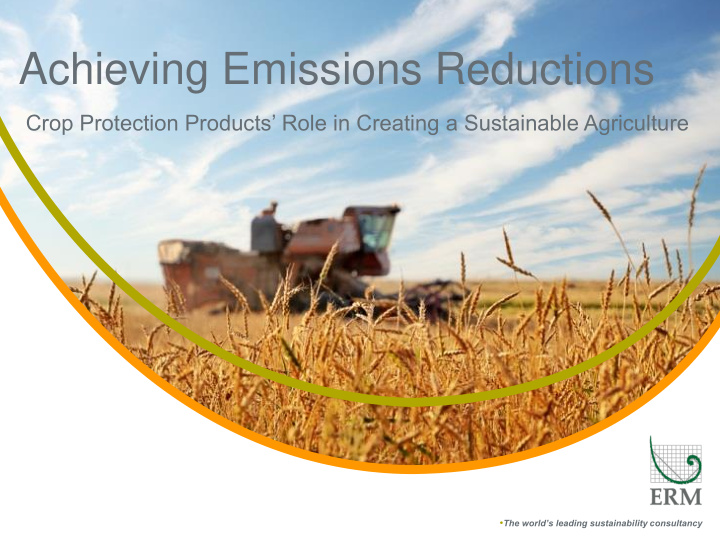



Achieving Emissions Reductions Crop Protection Products’ Role in Creating a Sustainable Agriculture • “Insert” then choose “Picture” – select your picture. Right click your picture and “Send to back”. • The world’s leading sustainability consultancy • The world’s leading sustainability consultancy
The threat from climate change Source: World Economic Forum, Global Risks 2012 Delivering sustainable solutions in a more competitive world
What will happen to agricultural greenhouse gas emissions as we address the increasing global demand for crops? Delivering sustainable solutions in a more competitive world
Feeding the World According to the United Nations, by 2050 • the world’s population is expected to reach 8.9 billion 1 • food production must increase by 70% to meet this growing demand 2 • And adapt to climate change itself • In 2005, agriculture accounted for 10%- 12% of total global anthropogenic GHG emissions 3 1 United Nations (2004), Department of Economic and Social Affairs/ Population Division, World Population to 2300 2 United Nation Food and Agricultural Organization (FAO) 3 Smith P, et al (2007) Agriculture. Climate Change 2007: Mitigation Contribution of Working Group III to the Fourth Assessment Report of the Intergovernmental Panel on Climate Change Delivering sustainable solutions in a more competitive world
What is Life Cycle Assessment & Carbon Footprinting? • LCA is a technique for assessing the environmental aspects and potential impacts associated with a product or service • by compiling an inventory of inputs and outputs; evaluating the potential environmental impacts; and interpreting the results of the inventory analysis (ISO 14040, 2006) • A product carbon footprint is a streamlined version of an LCA • focuses on greenhouse gases only, • reported as a single figure, carbon dioxide equivalents (CO 2 ) INPUTS eg energy, water raw materials Production Use growing eg seeds, food products/ harvesting & fertilisers, crop of crop biofuels Disposal protection EMISSIONS cradle to gate cradle to grave eg N 2 O from soil, CH 4 from manure Delivering sustainable solutions in a more competitive world
What activities contribute the most to the total greenhouse gas emissions associated with crop production? Delivering sustainable solutions in a more competitive world
GHG Emissions Associated with Maize Growing 6% 61% 31% Crop protection products Fertiliser production Fertiliser application 1% 1% Figure does not include for land use change Energy and fuels Other inputs • Key contributor to GHG emissions of maize growing is the production of and N 2 O emissions associated with the application of fertilisers • Higher yields are achieved through nutrient application, ie a balance to be created between yield and GHG emissions • Crop protection does not contribute significantly, accounting for 1% of the total Delivering sustainable solutions in a more competitive world
Carbon Footprint of the Cultivation of Cotton 34% 18% 44% Crop protection products Fertiliser production Fertiliser application 4% 1% Energy and fuels Other inputs • Key contributors to the GHG emissions associated with cotton production are energy and fertilizer production and application • Again, a direct link between yield and GHG emissions • Crop protection does not contribute significantly, accounting for 4% of the total Delivering sustainable solutions in a more competitive world
Industry Life Cycle Thinking Initiatives • Building a better understanding of the climate change impacts of and benefits with crop protection products in the context of agricultural production • Collaborate to calculate the average GHG emissions associated with CPP in order to meet demand for information and support further understanding of the GHG impacts of agriculture The average GHG emissions associated with the production of CPP is calculated to be 5.5 kg CO 2 e per litre of finished product This is based on a collaborative project between CropLife and the main producers and builds on company own information covering the ‘cradle -to- gate ’ aspects of CPP production Delivering sustainable solutions in a more competitive world
Monitoring progress towards meeting needs • Striking the right balance - between increasing yield and GHG emissions • And understanding how to achieve this • understanding the climate change impacts per tonne crop produced • Including monitoring progress • how key factors interlink to achieve improved yield • at a level that provides the best insight irrigation • model farms / pilots? nutrients • natural level? farming practices crop protection • regional level? IMPROVED farm machinery YIELD • all of the above temperature seeds harvesting techniques Delivering sustainable solutions in a more competitive world
Final Remarks • With growing populations and limited global land available for crop growing, yield gain is the focus area • Crop protection products play a key part in this • …and in adapting to climate change, their role may become even more important • Focus for the crop protection sector is to avoid crop loss at minimal GHG emissions • which means lower GHG emissions per quantity of crop produced • …not necessarily per quantity of CPP Delivering sustainable solutions in a more competitive world
About ERM ERM is a leading global provider of environmental, health, safety, risk and social consulting services in influential assignments. For over 40 years we have been working with clients around the world and in diverse industry sectors to help them to understand and manage their impacts. Over 4,00 employees in 40 countries across the globe. Over the past five years we have worked for approximately 60% of the Global Fortune 500. Contact details: Simon Aumônier Principal Partner simon.aumonier@erm.com Delivering sustainable solutions in a more competitive world
Recommend
More recommend